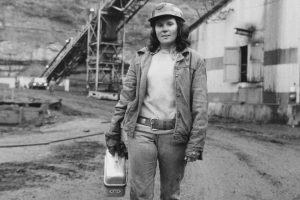Maggie Messitt at Poetry Magazine:
 By the time Eisenberg started as an apprentice, several events suggested that the gender barrier in construction, and in other industries, could finally be cracked. It had been 15 years since the passage of the Equal Pay Act, which prohibited wage differentials based on sex, and 14 years since the Civil Rights Act, which outlawed discrimination based on race, color, religion, national origin, and—at the eleventh hour—sex. (Labor unions strongly opposed the latter.) Almost a decade earlier, Gloria Steinem’s article “After Black Power, Women’s Liberation,” published in New York magazine, created small seismic shifts in homes and workplaces across America. The Equal Rights Amendment had finally passed, nearly a half-century after it was introduced, and was awaiting state ratification. (The ERA remains in constitutional limbo to this day. A faction of conservative women thwarted its passage, arguing that it would lead to the draft and eventually to unisex bathrooms.)
By the time Eisenberg started as an apprentice, several events suggested that the gender barrier in construction, and in other industries, could finally be cracked. It had been 15 years since the passage of the Equal Pay Act, which prohibited wage differentials based on sex, and 14 years since the Civil Rights Act, which outlawed discrimination based on race, color, religion, national origin, and—at the eleventh hour—sex. (Labor unions strongly opposed the latter.) Almost a decade earlier, Gloria Steinem’s article “After Black Power, Women’s Liberation,” published in New York magazine, created small seismic shifts in homes and workplaces across America. The Equal Rights Amendment had finally passed, nearly a half-century after it was introduced, and was awaiting state ratification. (The ERA remains in constitutional limbo to this day. A faction of conservative women thwarted its passage, arguing that it would lead to the draft and eventually to unisex bathrooms.)
In 1975, three years before Eisenberg started working on Boston construction sites, Time magazine awarded its annual Man of the Year honor to “American Women,” in recognition that the patriarchal gender balance was shifting across the country.
more here.
